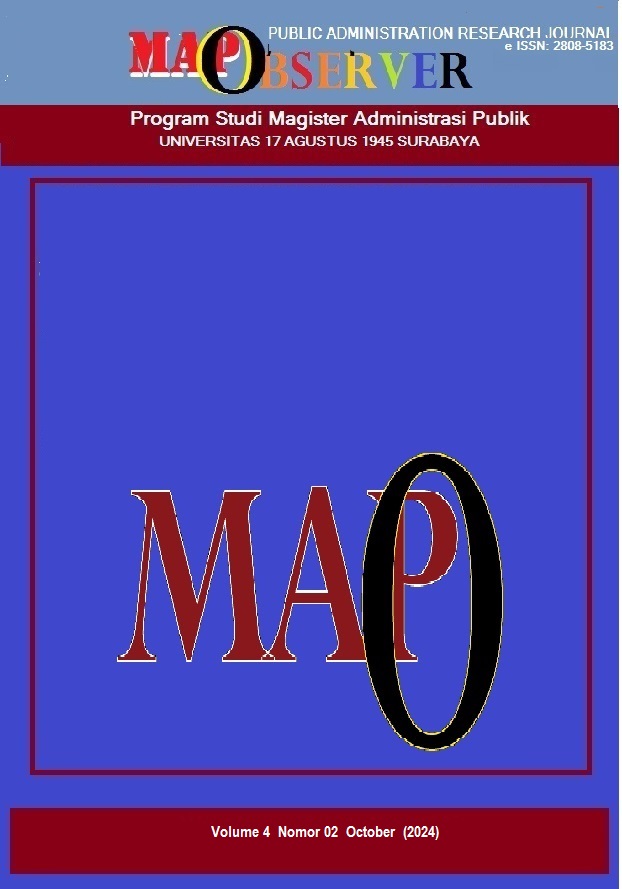LEVEL OF COMMUNITY PARTICIPATION IN BIRTH CERTIFICATE OWNERSHIP IN PERAK EAST DISTRICT, PABEAN CANTIAN DISTRICT, SURABAYA CITY
Abstract
A birth certificate is evidence or a sign that clarifies the child who was born, usually the legal status begins when the human is born from life to death. A birth certificate is strong evidence of the existence of a child because the birth certificate clearly states the day of birth, place of residence, date of birth, month of birth, and year of birth and it clearly states the names of the parents who gave birth. Therefore, this study discusses the level of community participation in the ownership of birth certificates. This study aims to measure the level of participation of the silver east community in the ownership of birth certificates. The type of research used in this research is descriptive quantitative. Descriptive quantitative research method is a method that aims to make a picture or descriptive about a situation objectively using numbers, starting from data collection, interpretation of the data as well as appearance and results. The data collection technique uses the questionnaire method, namely by giving a set or written questions or questions to respondents to be answered. Based on the results of research that has been carried out on the Level of Community Participation in Birth Certificate Ownership in Perak Timur Village, Pabean Cantian District, Surabaya City, the conclusions are: from the theory proposed by Keith Davis which has three indicators, namely individual mental and emotional involvement, individual motivation and individual responsibility, the highest value of the 3 indicators of community participation is 88%.
Downloads
References
Agus Widiyarta Ertien Rining N. (n.d.). PELAYANAN KESEHATAN DARI PERSPEKTIFPARTICIPATORY GOVERNANCE.
Arikuanto. (2014). Metode Deskriptip Kuantitatif. 1(69), 5–24.
Fadilah, G. N., & Maesaroh. (2020). Analisis Inovasi Pelayanan 6 In 1 (Elektronik Lahir Mati Pindah Datang) di Dispenduk Capil Kota Surabaya. Journal Of Public Policy And Management Review, 9(2), 1689–1699.
Himamalina, E., Ati, N. U., & Agus Zainal Abidin. (2021). TINGKAT PARTISIPASI MASYARAKAT DALAM KEPEMILIKAN AKTA KELAHIRAN (Studi Kasus di Desa Talok Kecamatan Dlanggu Kabupaten Mojokerto). Jurnal Respon Publik, 15(2), 22.
Lestari, E. (2015). Partisipasi masyarakat dalam administrasi kependudukan. In Universitas Negeri Surabaya. https://jurnalmahasiswa.unesa.ac.id/index.php/publika/article/view/12097
Mayangsari, A. S. (2017). Kajian Kesejahteraan Masyarakat. Fkip Ump, 4–8.
Syafri, Edi; Endrizal, N. (2013). Bab Ii Tinjaun Pustaka. Tingkat Partisipasi Masyarakat Dalam Pengembangan Pariwisata Di Kawasan Obyek Wisata Pantai Sipakario, 53(9), 1689–1699.
Taliziduhu Ndraha. (1990). Pembangunan masyarakat :mempersiapkan masyarakat tinggal landas / Taliziduhu Ndraha. [Jakarta] :: Rineka Cipta,
Copyright (c) 2024 Ervin Dewantara

This work is licensed under a Creative Commons Attribution-ShareAlike 4.0 International License.
-
The MAP Observer journal allows authors to retain the copyright of their papers without limitation. Authors may grant publishers non-exclusive publishing rights to publish articles. Granting first publishing rights to publishers also qualifies as unlimited copyright (because there are no restrictions imposed by publishers on author copyright).
-
Formal legal provisions for access to digital articles from these electronic journals are subject to the terms of the Creative Commons Attribution-ShareAlike (CC BY-SA) license, which means MAPO Observer Journal has the right to store, change formats, maintain in a database, maintain and publish articles without asking. permission from the Author as long as the Author's name is the owner of the Copyright.
-
Printed manuscripts and electronic publications are open access for educational, research and library purposes. Apart from these purposes, the editorial board is not responsible for violations of copyright law.





